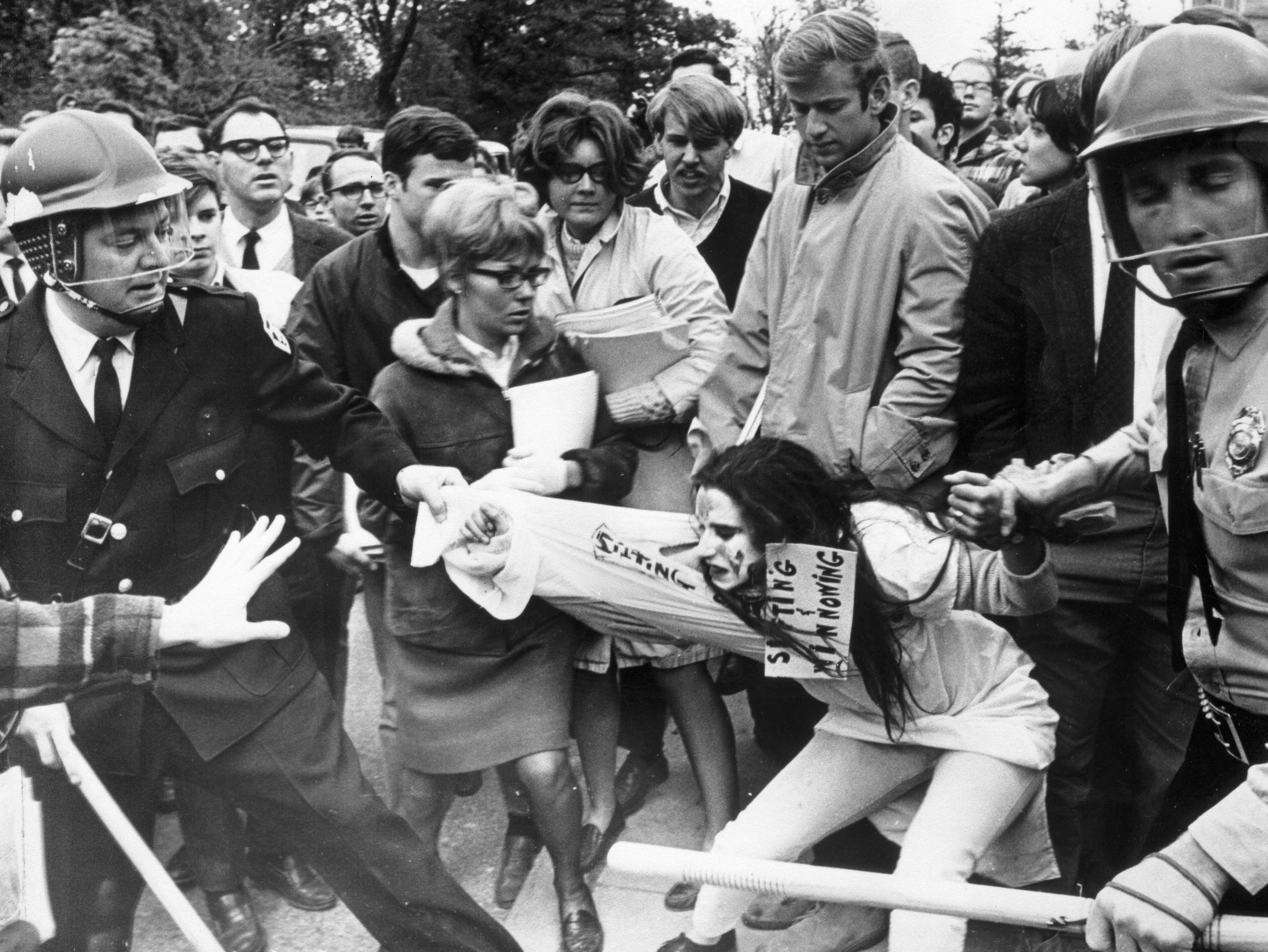Conflict Before the Storm
College Campuses & the Movement for Peace
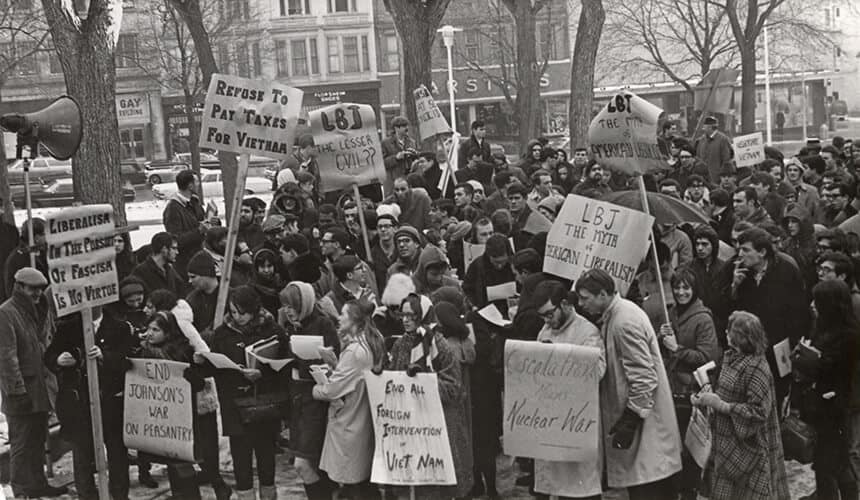
War Without End
By 1968, US involvement in the Vietnam war had dragged on for thirteen long years. As the death toll continued to rise, the American public became increasingly frustrated with what seemed a war without end. President Lyndon Johnson had continually reassured the American people that Communist North Vietnamese troops were being subdued and the war would soon draw to a close. This all changed in January of 1968, when the Viet Cong led a successful counterattack against U.S troops known as the Tet Offensive.
The insurgency crushed public perceptions of the war, leaving many shocked that the North Vietnamese were not in fact struggling and on the verge of defeat. Shortly afterwards, commander of US military operations in Vietnam General Westmoreland requested another 206,000 troops be drafted and deployed to put added pressure on the Vietcong. While President Johnson denied his request—understanding this would be a highly unpopular move—the truth was clear to the American public: the war was far from over.
That same year, as candidate for president, Richard Nixon campaigned on a promise to end what had become a highly unpopular war. Nixon swept to the presidency, but his November 1969 address to the nation revealed that promise was not to be.
A new demand for de-escalation began. As many young men anxiously awaited the day that their draft number would be called, and they too would be forced to abandon their current lives to go fight a war that many now saw a purposeless, frustration, fear and anger took root. The rising emotions of young people across the nation led to a new wave of protests, many taking place on college campuses, including UWEC.*
*While the University of WI Eau Claire (UWEC) was officially titled Wisconsin State University Eau Claire (WSU-EC) until 1971, for the purposes of cohesion and clarity, we refer to the university by its current name, UWEC, throughout the exhibit.

During the Johnson Administration (1963–1969), there were several opportunities for peace in Vietnam. Cy Hungerford’s cartoon is ironic, as President Johnson sinks into quicksand, grinning at the potential for peace. Will LBJ’s Luck Hold Out? Hungerford, C. Pittsburgh Post-Gazette. (1965–1968)
During the Johnson Administration (1963–1969), there were several opportunities for peace in Vietnam. Cy Hungerford’s cartoon is ironic, as President Johnson sinks into quicksand, grinning at the potential for peace. Will LBJ’s Luck Hold Out? Hungerford, C. Pittsburgh Post-Gazette. (1965–1968)
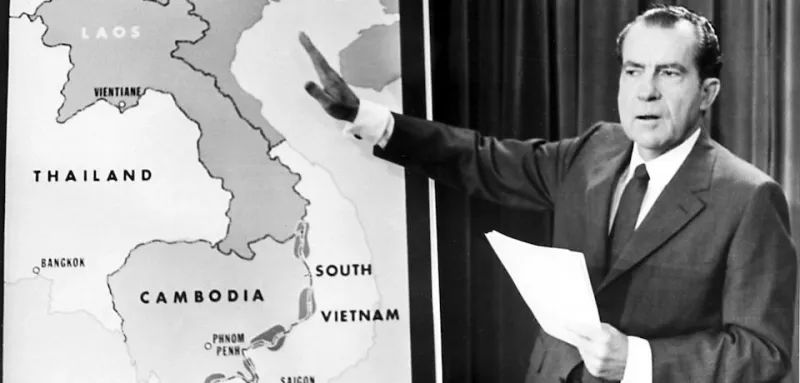
President Richard Nixon announces the entry of U.S. troops in Cambodia during a news conference. April 30, 1970.
President Richard Nixon announces the entry of U.S. troops in Cambodia during a news conference. April 30, 1970.
“I believe that one of the reasons for the deep division about Vietnam is that many Americans have lost confidence in what their government has told them about our policy. The American people cannot and should not be asked to support a policy which involves the overriding issues of war and peace unless they know the truth about that policy.”
Activism on College Campuses
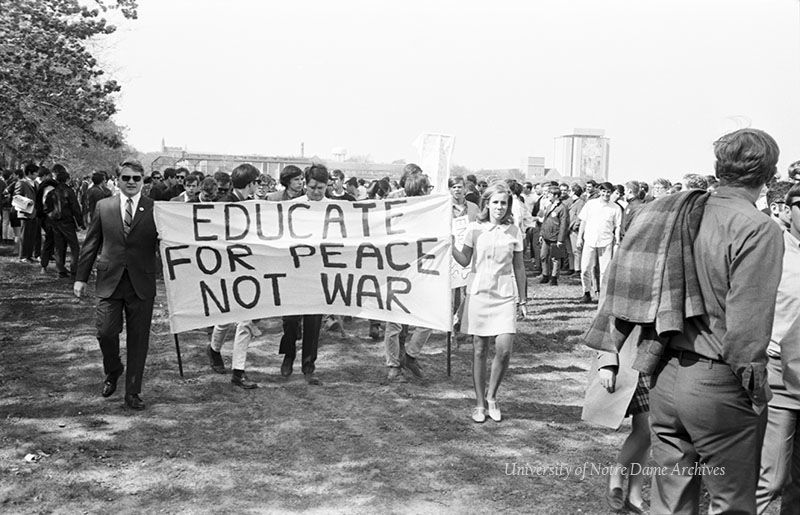
In the late 1960s and early 70s, universities across the nation became a focal point for activism related to the war, as administrators, faculty, and students expressed different stances on US involvement.
In the fall of 1969, UWEC President Leonard Hass referred to college campuses as “a main stream of American life” that would play a role in public perceptions of the war. As such, Haas believed it inappropriate “for this University as a public agency to take a formal position.” This decision—or rather, indecision— created a rift between administrators and students.
These debates occurred at a time when most universities adhered to a philosophy known as "In loco parentis," Latin for “in place of parents,” originating in the socially conservative 1950s. In essence, the notion granted colleges parental authority over students, leading to a more stifled atmosphere for campus public speech. But the growth of a national anti-war movement in the 1960s led students to rebel against these strict regulations, as they sought to express growing discontent with the war.
One national anti-war organization— Students for a Democratic Society (SDS) —were integral in this movement. However, in 1967, SDS was denied a charter at UWEC. Many students decried the decision, believing administration was censoring student free speech. In a clear illustration of the clash between students and admin over the issue, the UWEC student senate voted 11 to 3 in favor of allowing SDS to form a charter on campus,
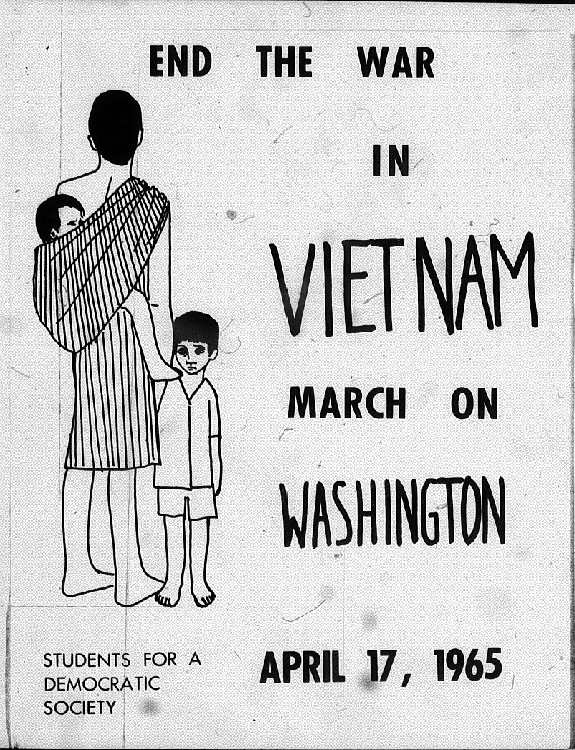
Promotional material for the SDS organized national march on Washington, D.C., Circa April 1965
Promotional material for the SDS organized national march on Washington, D.C., Circa April 1965
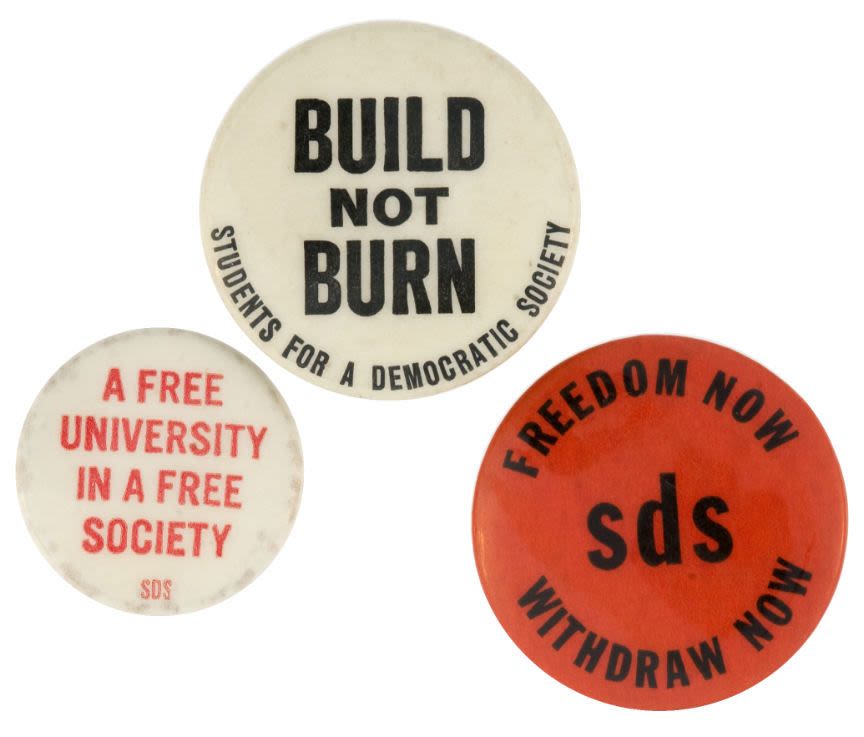
Paraphernalia for Student for a Democratic Society (SDS) Circa 1964-1965, Berkeley, CA.
Paraphernalia for Student for a Democratic Society (SDS) Circa 1964-1965, Berkeley, CA.

“Parade For Peace,” UWEC students, in affiliation with faculty and city residents, march in opposition to the strict regulations and rising tensions between the student body the administration over fervent disagreements including the right for students to organize, speak freely, and be in disagreement with their government in the spring of 1967. The Spectator, April 15, 1967.
“Parade For Peace,” UWEC students, in affiliation with faculty and city residents, march in opposition to the strict regulations and rising tensions between the student body the administration over fervent disagreements including the right for students to organize, speak freely, and be in disagreement with their government in the spring of 1967. The Spectator, April 15, 1967.
“I do not belong to SDS and do not necessarily support the views of the organization. But the freedom to organize is as precious as the freedom of speech and should be denied to no one. SDS was denied this right. Is this a trend?”
Increasing Pushback
In the early years of the war, the editorial pages of UWEC’s student newspaper The Spectator reflect a variety of sentiments from the student body, ranging from defending the right of students and university groups to organize on campus, to backlash against an approved university senate resolution in favor of U.S. policy in Vietnam.
During the height of student demonstrations on campus, the student senate, despite uncooperative pushback from university administrators, was in favor to revise the university constitution to better address the needs and aspirations of the student body.
WCLU Chippewa Valley Chapter President and Political Science Professor Dr. Sylvia Sipress asserted that the breakdown of working dynamics between admin and students was to blame for the unrest, saying that “a lack of communication between students and administrators that has been the cause of student demonstrations.”
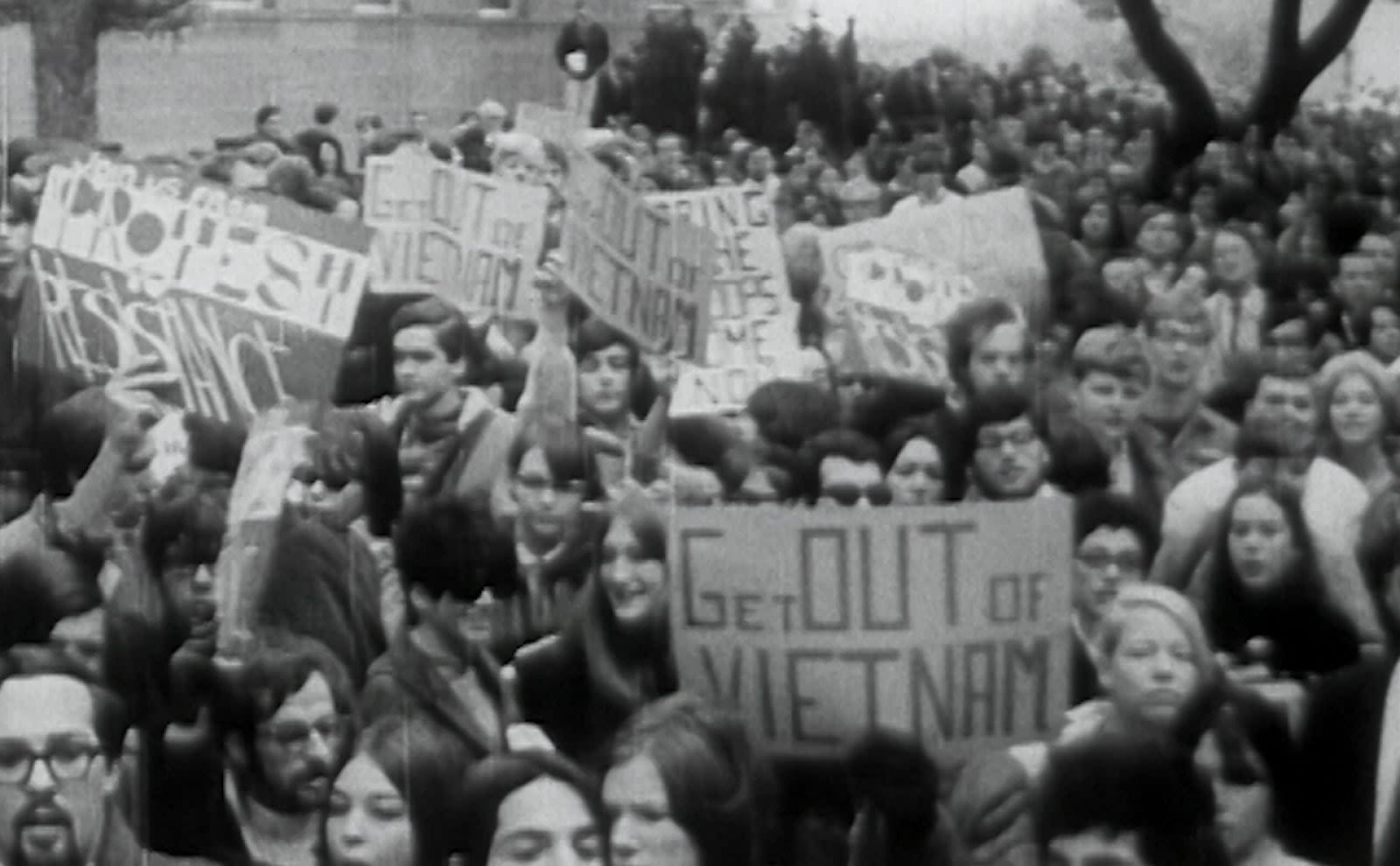
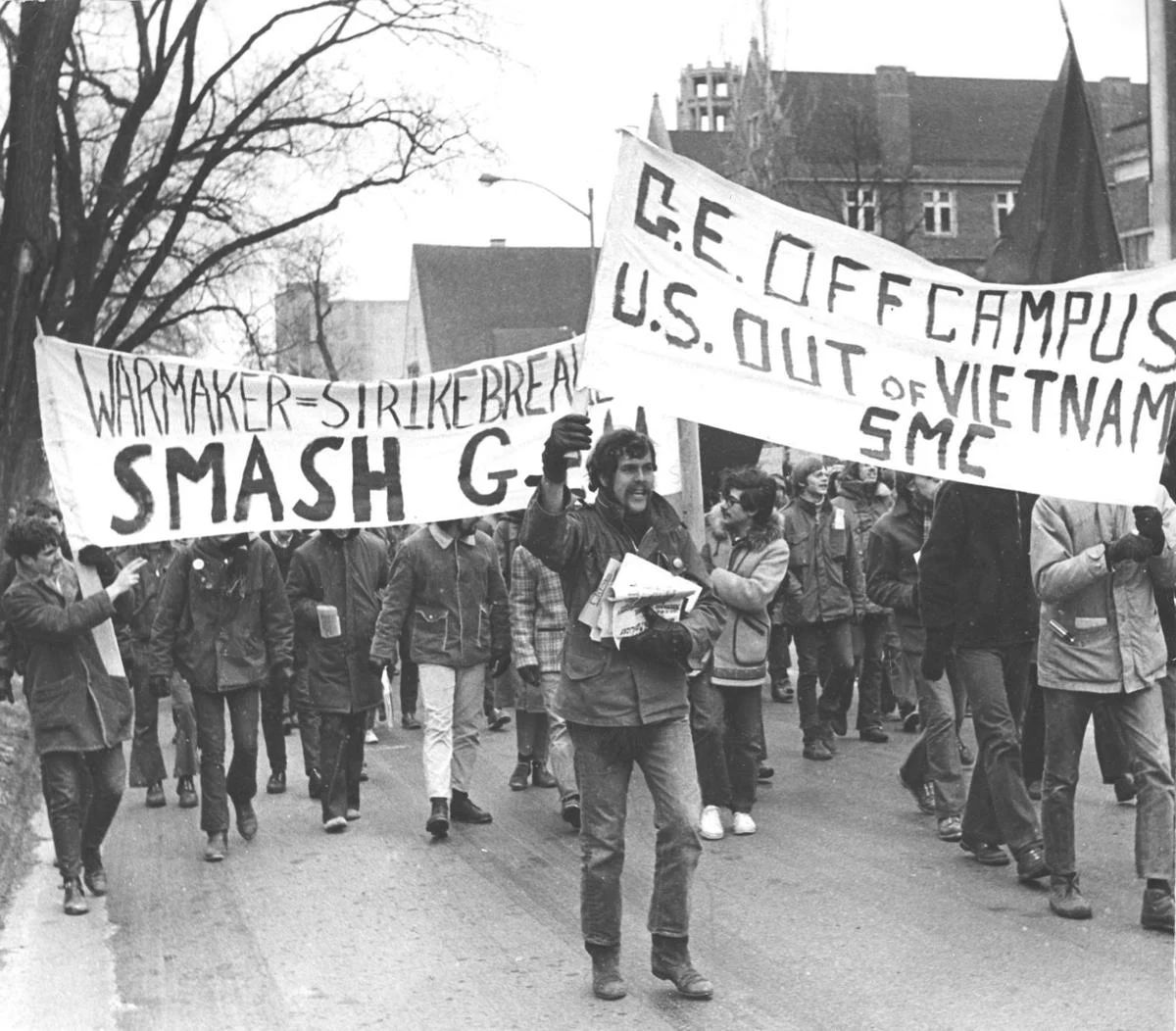
“An air of rebellion can and should be felt on this campus, but it is hidden behind the mask of the ‘Silent Generation’ of the Fifties.”
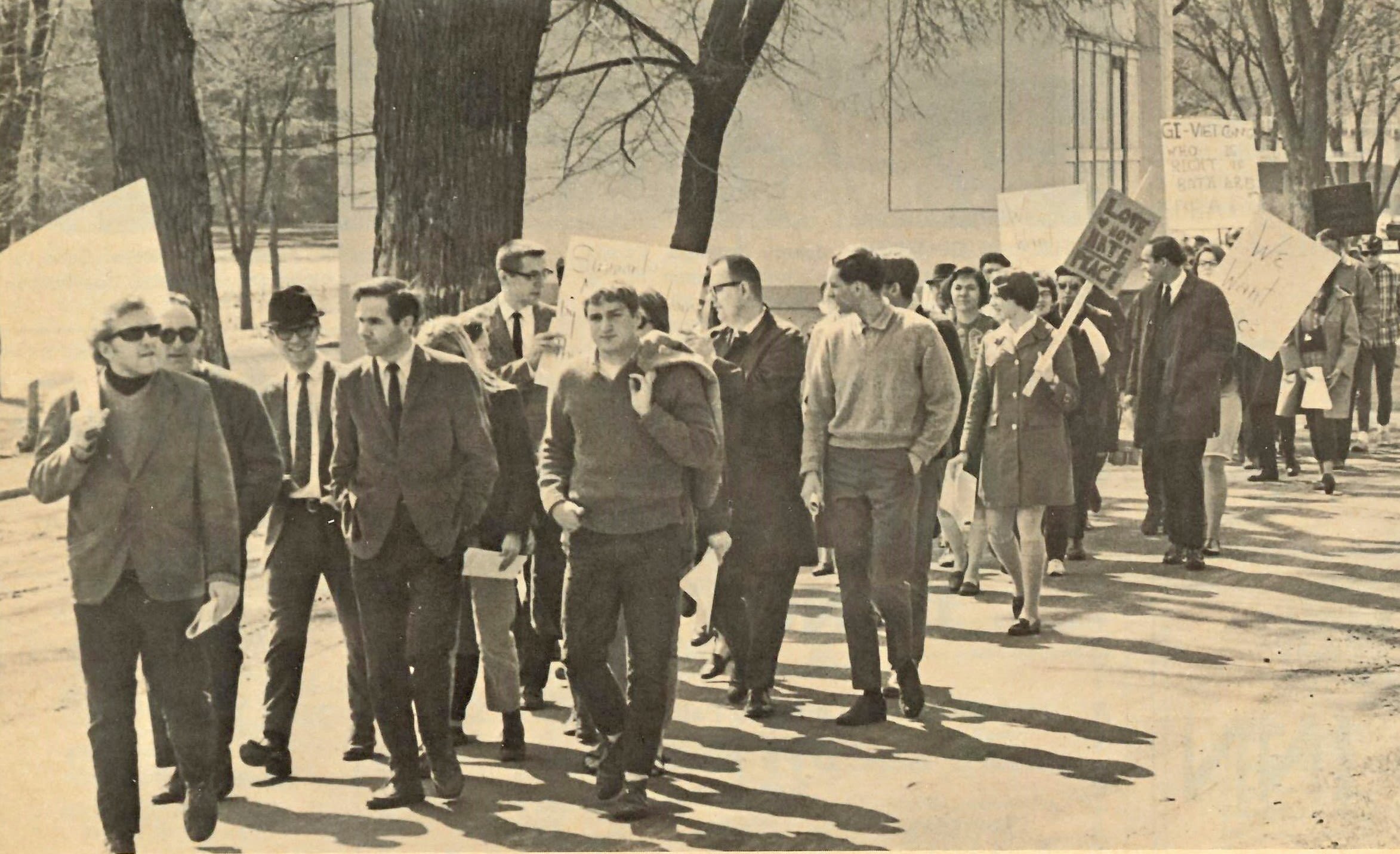
“The Spectator is supposed to be a student newspaper which reflects the opinions and interests of this university’s students. But this paper is actually a public relations organ of the university administration.”

One of many peace pamphlets handed out on campus to encourage wider engagement in local efforts to protest the Vietnam War. Howard Lutz Papers, UWEC Special Collections.
One of many peace pamphlets handed out on campus to encourage wider engagement in local efforts to protest the Vietnam War. Howard Lutz Papers, UWEC Special Collections.
Pressure for Peace: the 1969 Moratorium
On October 15, 1969, a nationwide movement known as the Moratorium to End the War began, encouraging demonstrations and teach-ins across the US. One month later, on November 15, 1969, activists from across the country converged in Moratorium March in Washington, D.C.
The movement encouraged everyday citizens to spend the day participating in anti-war programs and demonstrations. Rooted in campus activism, the moratorium expanded to include townhalls, debates, rallies, and candlelight vigils in cities across the country.
"If we are willing to boycott almost 40,000 lives in Vietnam, forever, we should be willing to “boycott” one day of classes. "
-Editorial titled "Moratorium a Learning Experience," The Spectator, October 2, 1969.
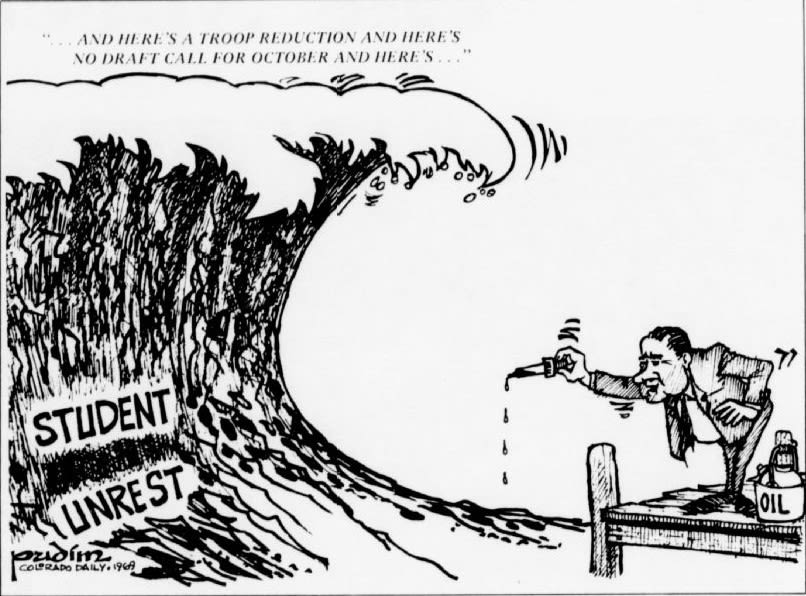
Political cartoon depicting growing student unrest as a massive wave headed towards President Nixon. Published in the UWEC Spectator, October 16, 1969.
Political cartoon depicting growing student unrest as a massive wave headed towards President Nixon. Published in the UWEC Spectator, October 16, 1969.
Two days before the scheduled start of the moratorium, UWEC students gathered at the federal building in Eau Claire for a 42-hour vigil where they read the names of 40,000 Americans who had died in Vietnam. As the son of then- US Secretary of Defense Melvin Laird, UWEC student John Laird was a prominent voice at the event. Speaking to the press, Laird said, “We want to show the concern all over the country, and the hope that the war will be over soon and that a peaceful demonstration like this can help bring an end to the war.”
On the night of October 15, 1969, protesters marched from the campus to downtown Eau Claire. Stopping at Owen Park bandshell for prayers and speeches from students and faculty. Nearly 2000 marchers filled the bridge across the Chippewa River and set their sights on the federal building downtown. Upon arrival, they placed a black wreath on the building and observed two minutes of silence.
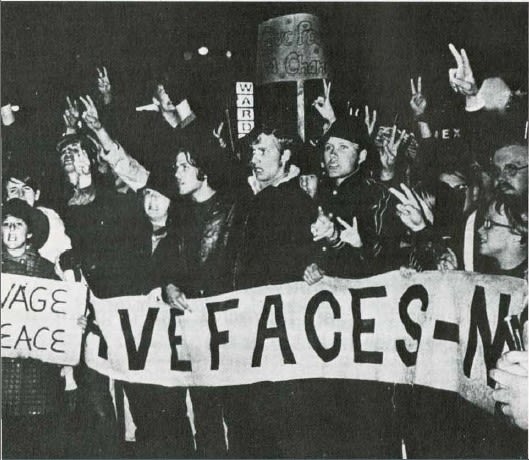
A Growing Movement
In this period, UWEC was only one of many campuses in Wisconsin that participated in the anti-war movement, including many in the UW system.
"What I fear is students will stop protesting...that we shall become more preoccupied with keeping the peace, than keeping the truth."
-Rev. James Larue, in a letter to the editor, addressing the DOW protest. Wisconsin State Journal, March 9th, 1967
While the moratorium in 1969 was an example of anti-war activism on Eau Claire's campus prior to Kent State, students at Madison were also getting organized two years prior. Students at Madison organized a sit in at DOW chemical plant in Madison to protest the company's role in the production of napalm, as well as job interviews hosted on campus.
This protest started peacefully until it was escalated by local police, leading to the injuries of multiple protestors. The police response to the DOW sit-in would set the tone for how law enforcement from the local to federal level would respond to civil disobedience against the Vietnam War, reaching its zenith at Kent State in 1970.
"The first important fact that must be faced squarely by all in this community is that there was brutality on the campus directed against the students who were peacefully protesting."
-Mrs. Walter Gregg, letter to the editor, Wisconsin Capital Times, October 25th, 1967


